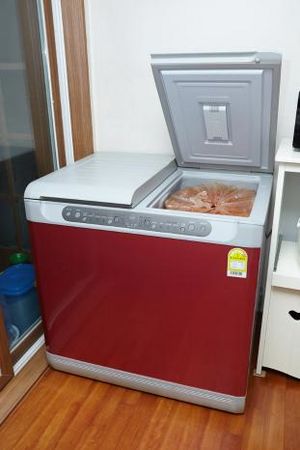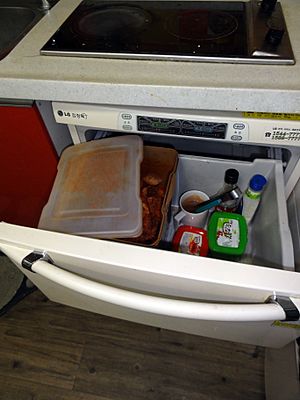Kimchi refrigerator facts for kids
| Kimchi refrigerator | |
 |
|
Quick facts for kids Korean name |
|
|---|---|
| Hangul |
김치냉장고
|
| Hanja |
김치冷藏庫
|
| Revised Romanization | gimchi naengjanggo |
| McCune–Reischauer | kimch'i naengjanggo |
A kimchi refrigerator is a special refrigerator made just for storing kimchi. It helps kimchi stay fresh and taste great. These fridges are colder and keep a more steady temperature than regular fridges. They also have more humidity and less moving air. This creates the perfect place for kimchi to go through fermentation. Fermentation is a process where tiny living things change food, making it last longer and giving it a unique flavor. Some kimchi fridges even have a special light called a UV Sterilizer to keep things extra clean.
In Korea, many people really want a kimchi refrigerator. A survey in 2004 showed it was the most desired household appliance for Korean families!
Discovering Kimchi Refrigerator History
The idea for a kimchi refrigerator started a long time ago. In 1984, a company called GoldStar, which is now LG, first used the name 'Kimchi refrigerator'. Their first model was called 'GR-063'. It had a stainless steel inside and you could set the temperature. This first fridge could hold about 45 liters of kimchi.
After many years of hard work, another company named WiniaMando created a popular brand called DIMCHAE. They launched their kimchi refrigerator to everyone in December 1995. This was a big step for kimchi fridges! By 2007, many companies, including Samsung and LG, were making these special refrigerators.
Exploring Kimchi Refrigerator Designs
Kimchi refrigerators come in different styles. The first ones were "top-loading" or "lid-type." This meant you lifted a lid to put kimchi inside. Sometimes, you had to lift heavy containers to reach the bottom.
Now, some models have two deep drawers at the bottom. These drawers are easy to reach from the outside. You can use these bins for kimchi, fresh fruits, vegetables, or even meats.
Newer models are "door-drawer types," also called "stand-type" in Korea. These fridges save space and are easier to use. Some have a single door with a special section at the top, like a wine bar. You can open just this small part to save energy. The top part can even be used as a freezer.


